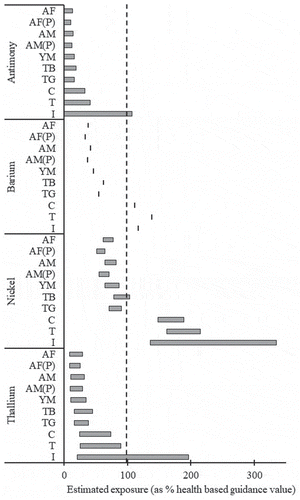Figures & data
Table 1. Analytical limits of reporting for different food matrices of 10 elements analysed in the New Zealand food supply.
Table 2. New Zealand population cohorts considered in dietary exposure assessment for 10 elements (Pearson etal. Citation2018b).
Table 3. Health-based guidance values used for risk characterisation of exposures to 10 elements in the New Zealand diet.
Table 4. Estimated lower-bound to upper-bound mean dietary exposures for 10 toxic elements in New Zealand population cohorts.
Figure 1. Characterised lower-bound– upper-bound mean exposure ranges for four elements where New Zealand population cohorts may exceed the health-based guidance value (marked by adotted line).
AF: Adult Female (25 years and over); AF(P): Adult Female– Pacific Island ethnicity (15 years and over); AM: Adult Male (25 years and over); AM(P): Adult Male– Pacific Island ethnicity (15 years and over); YM: Young Adult Male (19–24 years); TB: Teenage Boy (11–14 years); TG: Teenage Girl (11–14 years); C: Child (5–6 years); T: Toddler (1–3 years); I: Infant (6–12 months).

Table 5. Portion sizes, up to 100 g, for nickel-rich foods necessary to lead to an exceedance of the hypersensitivity reference point for adult females (25 years and above).
